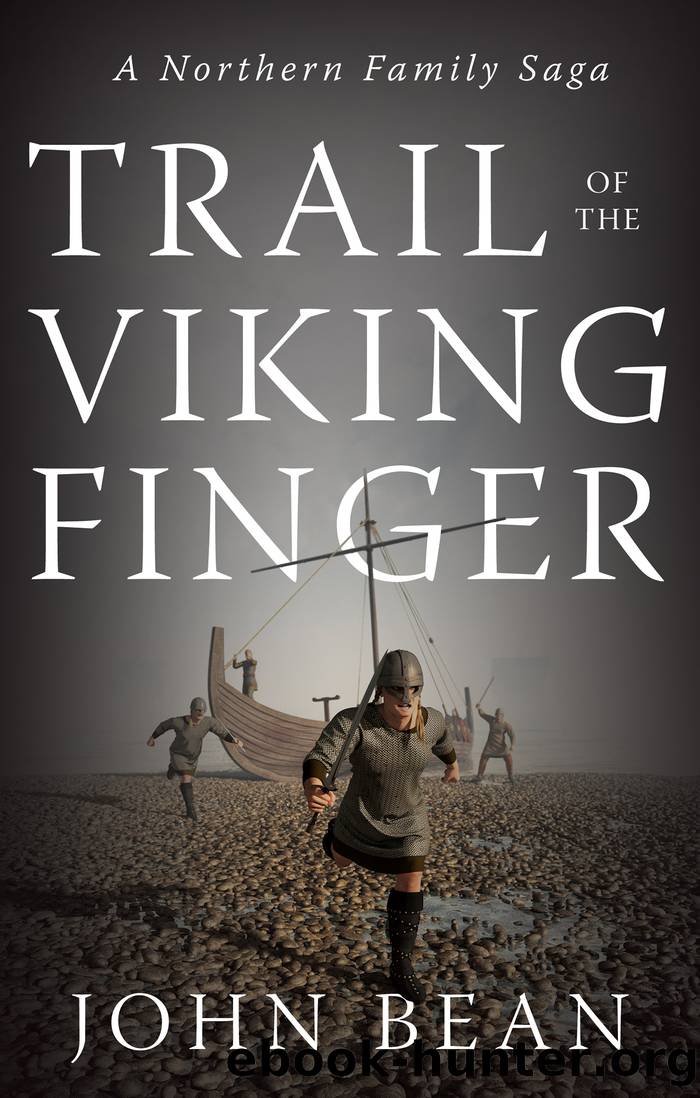Trail of the Viking Finger by John Bean

Author:John Bean
Language: eng
Format: epub
Publisher: Troubador Publishing Ltd
Published: 2016-08-05T00:00:00+00:00
A week later a conference was called to discuss ways of overcoming the downturn in their farm harvests and whether or not they were concentrating on the right crops, or should they expand the areas down to pasture so they could increase the raising of livestock. Present as chairman was Richard Byrne, now fifty-four, his son Bryan and wife Anne, Richardâs youngest son Cedric (now eighteen), Arthur, the son of the late Thomas Byrne, John Byrne, another fit fifty-year-old, representing the smaller farm land at Appleton. Also present was Ivor Fairhall a cousin who lived nearby at Sherborn. His grandparents had left York when their jewellery business went bankrupt following a robbery. On the days when Ivor did not come over to help on the land, he worked as a part-time ironsmith specialising in making decorative ironwork and even basic jewellery.
It was decided without any real dissent that there was little they could do to improve profitability with any new crops, other than supporting any promotions in York for people to eat more potatoes, even where it meant a discount on price.
The four youngest â Bryan, Anne, Arthur and Cedric â were keen on increasing production of livestock. Bryan and Anne handed out a number of leaflets showing the views of Robert Bakewell who was fast making a name for himself all over Britain with revolutionary new breeding techniques. These called for grassland irrigation and flooding (in both of which the Byrnes had gained considerable experience) and fertilising the pasture lands to improve grazing. Soon, all of them were interested, particularly with the idea of cross-breeding sheep from native stocks to give a meaty body with long wool.
Robert Bakewell was the first to breed cattle to be used primarily for beef. Previously cattle were first and foremost kept for pulling ploughs â as oxen were. He crossed long-horned heifers and a Westmoreland bull to eventually create the Dishley Longhorn. In 1700 the average weight of a bull sold for slaughter was 370 pounds. By 1786 that weight had more than doubled to 840 pounds.
Within five years the Byrnes were beginning to see a better living as a result of applying Bakewellâs techniques to the raising of improved sheep stock and some cattle. The original scepticism of Richard and John Byrne had been won over. What is more the potato crops in Church Fenton were doing well in most years and more and more ordinary people throughout England were now eating them. The acreage formerly devoted to wheat, barley and beans was now reduced and most of the crop was for animal feed.
Bryan and Anne were also happy with their immediate family. Their first child, a girl, had only lived for three months. The next child, Matilda had got through the childhood diseases that took so many and was now a healthy girl of ten, her eight-year-old brother William was tall and strong for his age, but on occasions afflicted the family with outbursts of temper.
More than once when the two children were playing together Anne had said to Bryan, âLook at those two.
Download
This site does not store any files on its server. We only index and link to content provided by other sites. Please contact the content providers to delete copyright contents if any and email us, we'll remove relevant links or contents immediately.
| General | Copenhagen |
Room 212 by Kate Stewart(5040)
The Crown by Robert Lacey(4723)
Endurance: Shackleton's Incredible Voyage by Alfred Lansing(4677)
The Iron Duke by The Iron Duke(4293)
The Rape of Nanking by Iris Chang(4139)
Joan of Arc by Mary Gordon(4015)
Killing England by Bill O'Reilly(3953)
Say Nothing by Patrick Radden Keefe(3903)
I'll Give You the Sun by Jandy Nelson(3359)
Shadow of Night by Deborah Harkness(3304)
Hitler's Monsters by Eric Kurlander(3269)
Mary, Queen of Scots, and the Murder of Lord Darnley by Alison Weir(3150)
Blood and Sand by Alex Von Tunzelmann(3140)
Darkest Hour by Anthony McCarten(3072)
Eleanor & Park by Rainbow Rowell(3063)
Margaret Thatcher: The Autobiography by Thatcher Margaret(3029)
Red Famine: Stalin's War on Ukraine by Anne Applebaum(2873)
Book of Life by Deborah Harkness(2868)
The One Memory of Flora Banks by Emily Barr(2803)
